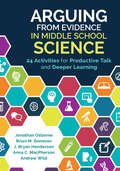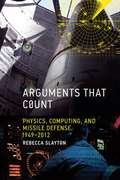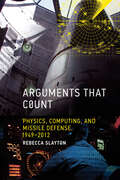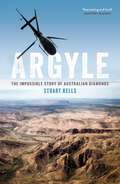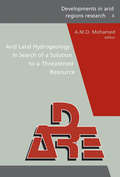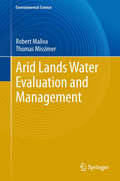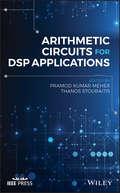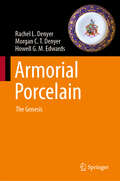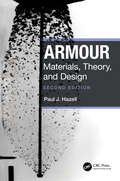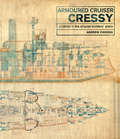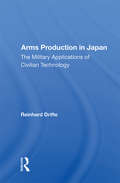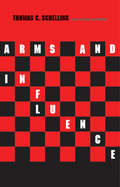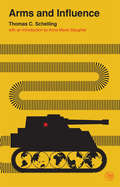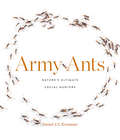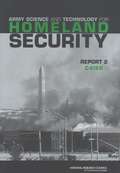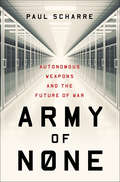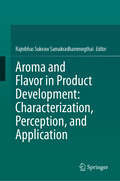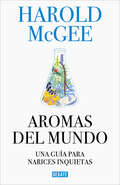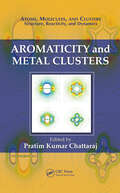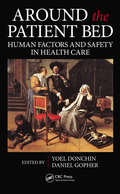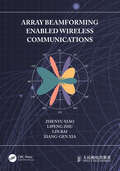- Table View
- List View
Arguing From Evidence in Middle School Science: 24 Activities for Productive Talk and Deeper Learning
by Brian M. Donovan Anna C. MacPherson Andrew J. Wild Jonathan Francis Osborne J. (Joseph) HendersonTeaching your students to think like scientists starts here! If you’ve ever struggled to help students make scientific arguments from evidence, this practical, easy-to-use activity book is for you! Give your students the critical scientific practice today′s science standards require. You’ll discover strategies and activities to effectively engage students in arguments about competing data sets, opposing scientific ideas, applying evidence to support specific claims, and more. 24 ready-to-implement activities drawn from the physical sciences, life sciences, and earth and space sciences help teachers to: Align lessons to the Next Generation Science Standards (NGSS) Engage students in the 8 NGSS science and engineering practices Establish rich, productive classroom discourse Facilitate reading and writing strategies that align to the Common Core State Standards Extend and employ argumentation and modeling strategies Clarify the difference between argumentation and explanation Includes assessment guidance and extension activities. Learn to teach the rational side of science the fun way with this simple and straightforward guide!
Arguments that Count
by Rebecca SlaytonIn a rapidly changing world, we rely upon experts to assess the promise and risks of new technology. But how do these experts make sense of a highly uncertain future? In Arguments that Count, Rebecca Slayton offers an important new perspective. Drawing on new historical documents and interviews as well as perspectives in science and technology studies, she provides an original account of how scientists came to terms with the unprecedented threat of nuclear-armed intercontinental ballistic missiles (ICBMs). She compares how two different professional communities -- physicists and computer scientists -- constructed arguments about the risks of missile defense, and how these arguments changed over time. Slayton shows that our understanding of technological risks is shaped by disciplinary repertoires -- the codified knowledge and mathematical rules that experts use to frame new challenges. And, significantly, a new repertoire can bring long-neglected risks into clear view. <P> In the 1950s, scientists recognized that high-speed computers would be needed to cope with the unprecedented speed of ICBMs. But the nation's elite science advisors had no way to analyze the risks of computers so used physics to assess what they could: radar and missile performance. Only decades later, after establishing computing as a science, were advisors able to analyze authoritatively the risks associated with complex software -- most notably, the risk of a catastrophic failure. As we continue to confront new threats, including that of cyber attack, Slayton offers valuable insight into how different kinds of expertise can limit or expand our capacity to address novel technological risks.
Arguments that Count: Physics, Computing, and Missile Defense, 1949-2012 (Inside Technology)
by Rebecca SlaytonHow differing assessments of risk by physicists and computer scientists have influenced public debate over nuclear defense.In a rapidly changing world, we rely upon experts to assess the promise and risks of new technology. But how do these experts make sense of a highly uncertain future? In Arguments that Count, Rebecca Slayton offers an important new perspective. Drawing on new historical documents and interviews as well as perspectives in science and technology studies, she provides an original account of how scientists came to terms with the unprecedented threat of nuclear-armed intercontinental ballistic missiles (ICBMs). She compares how two different professional communities—physicists and computer scientists—constructed arguments about the risks of missile defense, and how these arguments changed over time. Slayton shows that our understanding of technological risks is shaped by disciplinary repertoires—the codified knowledge and mathematical rules that experts use to frame new challenges. And, significantly, a new repertoire can bring long-neglected risks into clear view.In the 1950s, scientists recognized that high-speed computers would be needed to cope with the unprecedented speed of ICBMs. But the nation's elite science advisors had no way to analyze the risks of computers so used physics to assess what they could: radar and missile performance. Only decades later, after establishing computing as a science, were advisors able to analyze authoritatively the risks associated with complex software—most notably, the risk of a catastrophic failure. As we continue to confront new threats, including that of cyber attack, Slayton offers valuable insight into how different kinds of expertise can limit or expand our capacity to address novel technological risks.
Argyle: The Impossible Story of Australian Diamonds
by Stuart KellsThe remote Kimberley region of Western Australia has a rich history and unique geography. In the 1960s De Beers, the world's largest diamond company, sent gem-hunters to the area but they came away empty-handed. It was a vast region to survey, and they'd overlooked something vital. A few years later, a team of Australian geologists with a tiny budget searched for even tinier mineral clues. Those clues led them to the earth's largest diamond deposit and the world's richest source of rare pink diamonds. Based on in-depth research and interviews - including with Alan King Jones, Bill Leslie and 'the father of Australian diamonds', Ewen Tyler - Argyle: The Impossible Story of Australian Diamonds details the almost overwhelming challenges with realising a diamond mining venture in Australia, shows how these obstacles were overcome, and explores the mine's impact and legacy.
Arid Land Hydrogeology: Proceedings of the Third Joint UAE-Japan Symposium on Sustainable GCC Environment and Water Resources (EWR2006), 28 - 30 January 2006, Abu Dhabi, UAE (Volume IV in DARE series) (Developments in Arid Regions Research Series)
by A.M.O. MohamedThere are many urgent problems in arid land hydrogeology and it is these issues which are tackled in this volume on desert environments. The UAE-Japan symposia provide a venue for the exchange of expertise, confronting such problems as purification, usage and management of groundwater, the assessment and protection of sustainable water resources, a
Arid Lands Water Evaluation and Management (Environmental Science and Engineering)
by Robert Maliva Thomas MissimerA large part of the global population lives in arid lands which have low rainfall and often lack the water required for sustainable population and economic growth. This book presents a comprehensive description of the hydrogeology and hydrologic processes at work in arid lands. It describes the techniques that can be used to assess and manage the water resources of these areas with an emphasis on groundwater resources, including recent advances in hydrologic evaluation and the differences between how aquifer systems behave in arid lands versus more humid areas. Water management techniques are described and summarized to show how a more comprehensive approach to water management is required in these areas, including the need to be aware of cultural sensitivities and conditions unique to many arid regions. The integration of existing resources with the addition of new water sources, such as desalination of brackish water and seawater, along with reusing treated wastewater, will be required to meet future water supply needs. Also, changing climatic conditions will force water management systems to be more robust so that future water supply demands can be met as droughts become more intense and rainfall events become more intense. A range of water management techniques are described and discussed in order to illustrate the methods for integrating these measures within the context of arid lands conditions.
Arithmetic Circuits for DSP Applications
by Thanos Stouraitis Pramod Kumar MeherA comprehensive guide to the fundamental concepts, designs, and implementation schemes, performance considerations, and applications of arithmetic circuits for DSP Arithmetic Circuits for DSP Applications is a complete resource on arithmetic circuits for digital signal processing (DSP). It covers the key concepts, designs and developments of different types of arithmetic circuits, which can be used for improving the efficiency of implementation of a multitude of DSP applications. Each chapter includes various applications of the respective class of arithmetic circuits along with information on the future scope of research. Written for students, engineers, and researchers in electrical and computer engineering, this comprehensive text offers a clear understanding of different types of arithmetic circuits used for digital signal processing applications. The text includes contributions from noted researchers on a wide range of topics, including a review of circuits used in implementing basic operations like additions and multiplications; distributed arithmetic as a technique for the multiplier-less implementation of inner products for DSP applications; discussions on look up table-based techniques and their key applications; CORDIC circuits for calculation of trigonometric, hyperbolic and logarithmic functions; real and complex multiplications, division, and square-root; solution of linear systems; eigenvalue estimation; singular value decomposition; QR factorization and many other functions through the use of simple shift-add operations; and much more. This book serves as a comprehensive resource, which describes the arithmetic circuits as fundamental building blocks for state-of-the-art DSP and reviews in - depth the scope of their applications.
Arithmetic and Algebraic Circuits (Intelligent Systems Reference Library #201)
by Antonio Lloris Ruiz Encarnación Castillo Morales Luis Parrilla Roure Antonio García Ríos María José Lloris MeseguerThis book presents a complete and accurate study of arithmetic and algebraic circuits. The first part offers a review of all important basic concepts: it describes simple circuits for the implementation of some basic arithmetic operations; it introduces theoretical basis for residue number systems; and describes some fundamental circuits for implementing the main modular operations that will be used in the text. Moreover, the book discusses floating-point representation of real numbers and the IEEE 754 standard. The second and core part of the book offers a deep study of arithmetic circuits and specific algorithms for their implementation. It covers the CORDIC algorithm, and optimized arithmetic circuits recently developed by the authors for adders and subtractors, as well as multipliers, dividers and special functions. It describes the implementation of basic algebraic circuits, such as LFSRs and cellular automata. Finally, it offers a complete study of Galois fields, showing some exemplary applications and discussing the advantages in comparison to other methods. This dense, self-contained text provides students, researchers and engineers, with extensive knowledge on and a deep understanding of arithmetic and algebraic circuits and their implementation.
Arizona's Historic Bridges
by Patricia D. Morris Jerry A. CannonArizona was once just a passage for pioneers headed west for gold, religious freedom, and cheap land. Native Americans had lived in and explored the territory for years, but it was Manifest Destiny and the western expansionist philosophy of the burgeoning US government that created the impetus for better and faster routes across the vast territory with its topographical challenges. In the 1880s, the railroads first booted their way across the landscape, following historic trails before the highways were built. The Grand Canyon and Colorado River were obvious challenges, but there were also seasonal waterways that needed crossings. The history of the state unfolds with this book, profiling the bridges that define these historic transportation routes. Many of them have been proudly restored by their communities or the state, while others are gone or are in a sad state of decline.
Arming the Periphery
by Emrys ChewA major historical study of the global arms trade, revolving around the transfer of small arms from metropolitan Europe to the turbulent frontiers of Indian Ocean societies during the 'long' nineteenth century (c. 1780-1914).
Armorial Porcelain: The Genesis
by Howell G. Edwards Rachel L. Denyer Morgan C.T. DenyerThis book explores the genesis of armorial porcelain manufacture in Britain. While heraldic devices began appearing on Chinese porcelain from the sixteenth century onwards, armorials did not appear on British porcelain until the 1750s. It examines the development of porcelain in China and traces its introduction to Western Europe. The book delves into the market for armorial porcelains, from the early commissioning of Chinese armorial porcelainware to the establishment of manufactories in England capable of producing armorial porcelain. It also discusses the reasons behind the timing of armorial porcelain's manufacture in Britain. Additionally, it assesses armorial porcelain as a contemporary historical source. Building upon previous research by the authors, the book presents armorial porcelain as a distinct and highly personalized product. By integrating detailed genealogical research, cultural insights, and chemical analysis, it offers a comprehensive understanding of armorial porcelain within the context of heritage, culture, and science.
Armour: Materials, Theory, and Design
by Paul J. HazellUpdated throughout for the new edition, Armour: Materials, Theory, and Design covers extant and emergent protection technologies driving advances in armour systems. Covering materials, theory and design, the book has applications in vehicle, ship, personnel and building use.Introducing a wide range of armour technologies, the book is a key guide to the technology used to protect against both blasts and ballistic attacks. Chapters cover bullets, blasts, jets and fragments, as well as penetration mechanics. The new edition builds on the previous one, discussing ceramics and metallic materials as well as woven fabrics and composite laminates. Detailing modern technology advancements, the second edition has also been expanded to include improved explanations on shock mechanisms and includes significantly more figures and diagrams.An essential guide to armour technology, this book outlines key ways to implement protective strategies applicable for many types of conflict.
Armoured Cruiser Cressy: Detailed in the Original Builders' Plans
by Andrew ChoongThe complete set of builders’ plans for the Royal Navy’s Victorian era armored cruiser famously sunk during WWI.The builders of British warships created a highly detailed set of plans for each ship upon completion. These highly detailed, multicolored drawings represented the exact appearance and specifications of the ship as it entered service. Today, the National Maritime Museum and Seaforth Publishing are making these invaluable resources available to the public through a series of books featuring high-quality digital reproductions.This volume presents the plans for the armored cruiser HMS Cressy. Launched on December 4th, 1899, it best known for the disaster of September 22nd, 1914, in which Cressy and two sister-ships were sunk by a small submarine. Though obsolete by the First World War, Cressy-class cruisers were innovative ships in their day.In full color, with many close-ups and enlargements, these plans make every aspect of the HMS Cressy clear and comprehensible. Extensive captions point the reader to important features to be found in the plans, and an introduction covers the design’s background.
Arms Production In Japan: The Military Applications Of Civilian Technology
by Reinhard DrifteAlthough Japan's arms industry is still relatively small, significant political, economic, and technological developments indicate its growing importance and pave the way for Japan's increasing involvement in arms production. In this comprehensive study, Dr. Drifte examines both the domestic and international environments that are encouraging Japan
Arms and Influence
by Prof. Thomas C. SchellingThe author concentrates in this book n the way in which military capabilities real or imagined are used, skillfully of clumsily, as bargaining power. He sees the steps taken by the U. S. during the Berlin and Cuban crises as not merely preparations for engagement, but as signals to and enemy, with reports from the adversary's own military intelligence as our most important diplomatic communications.
Arms and Influence (Veritas Paperbacks)
by Thomas C. Schelling&“This is a brilliant and hardheaded book. It will frighten those who prefer not to dwell on the unthinkable and infuriate those who have taken refuge in stereotypes and moral attitudinizing.&”—Gordon A. Craig, New York Times Book Review Originally published more than fifty years ago, this landmark book explores the ways in which military capabilities—real or imagined—are used, skillfully or clumsily, as bargaining power. Anne-Marie Slaughter&’s new introduction to the work shows how Schelling&’s framework—conceived of in a time of superpowers and mutually assured destruction—still applies to our multipolar world, where wars are fought as much online as on the ground.
Army Ants: Nature's Ultimate Social Hunters
by Daniel J. KronauerA richly illustrated, captivating study of army ants, nature’s preeminent social hunters.A swarm raid is one of nature’s great spectacles. In tropical rainforests around the world, army ants march in groups by the thousands to overwhelm large solitary invertebrates, along with nests of termites, wasps, and other ants. They kill and dismember their prey and carry it back to their nest, where their hungry brood devours it. They are the ultimate social hunters, demonstrating the most fascinating collective behavior.In Army Ants we see how these insects play a crucial role in promoting and sustaining the biodiversity of tropical ecosystems. The ants help keep prey communities in check while also providing nutrition for other animals. Many species depend on army ants for survival, including a multitude of social parasites, swarm-following birds, and flies. And while their hunting behavior, and the rules that govern it, are clearly impressive, army ants display collective behavior in other ways that are no less dazzling. They build living nests, called bivouacs, using their bodies to protect the queen and larvae. The ants can even construct bridges over open space or obstacles by linking to one another using their feet. These incredible feats happen without central coordination. They are the result of local interactions—self-organization that benefits the society at large.Through observations, stories, and stunning images, Daniel Kronauer brings these fascinating creatures to life. Army ants may be small, but their collective intelligence and impact on their environment are anything but.
Army Science And Technology For Homeland Security: Report 2
by Committee on Army Science Technology for Homeland Defense--C4ISRShortly after the events of September 11, 2001, the U.S. Army asked the National Research Council (NRC) for a series of reports on how science and technology could assist the Army meet its Homeland defense obligations. The first report, Science and Technology for Army Homeland Security—Report 1, presented a survey of a road range of technologies and recommended applying Future Force technologies to homeland security wherever possible. In particular, the report noted that the Army should play a major role in providing emergency command, control, communications, computers, intelligence, surveillance, and reconnaissance (C4ISR) capabilities and that the technology and architecture needed for homeland security C4ISR was compatible with that of the Army’s Future Force. This second report focuses on C4ISR and how it can facilitate the Army’s efforts to assist the Department of Homeland Security (DHS) and emergency responders meet a catastrophic event.
Army of None: Autonomous Weapons And The Future Of War
by Paul ScharreA Pentagon defense expert and former U.S. Army Ranger explores what it would mean to give machines authority over the ultimate decision of life or death. <P><P> What happens when a Predator drone has as much autonomy as a Google car? Or when a weapon that can hunt its own targets is hacked? Although it sounds like science fiction, the technology already exists to create weapons that can attack targets without human input. Paul Scharre, a leading expert in emerging weapons technologies, draws on deep research and firsthand experience to explore how these next-generation weapons are changing warfare. <P><P> Scharre’s far-ranging investigation examines the emergence of autonomous weapons, the movement to ban them, and the legal and ethical issues surrounding their use. He spotlights artificial intelligence in military technology, spanning decades of innovation from German noise-seeking Wren torpedoes in World War II—antecedents of today’s homing missiles—to autonomous cyber weapons, submarine-hunting robot ships, and robot tank armies. Through interviews with defense experts, ethicists, psychologists, and activists, Scharre surveys what challenges might face "centaur warfighters" on future battlefields, which will combine human and machine cognition. We’ve made tremendous technological progress in the past few decades, but we have also glimpsed the terrifying mishaps that can result from complex automated systems—such as when advanced F-22 fighter jets experienced a computer meltdown the first time they flew over the International Date Line. <P><P>At least thirty countries already have defensive autonomous weapons that operate under human supervision. Around the globe, militaries are racing to build robotic weapons with increasing autonomy. The ethical questions within this book grow more pressing each day. To what extent should such technologies be advanced? And if responsible democracies ban them, would that stop rogue regimes from taking advantage? At the forefront of a game-changing debate, Army of None engages military history, global policy, and cutting-edge science to argue that we must embrace technology where it can make war more precise and humane, but without surrendering human judgment. When the choice is life or death, there is no replacement for the human heart.
Aroma and Flavor in Product Development: Characterization, Perception, and Application
by Rajnibhas Sukeaw SamakradhamrongthaiOne of the greatest challenges facing food product developers today is that of preserving aroma and flavor stability over time without comprising quality. With Aroma and Flavor in Product Development: Characterization, Perception, and Application, researchers and product innovators will find a thorough elucidation of the dynamic interplay of aroma and flavor in complex formulations across various applications, and of the crucial role of foundational elements in crafting globally appealing products. This guide provides essential insights into perception, formation, and development, enabling developers to enhance food items' organoleptic qualities and thereby provide consumers with an enhanced sensory experience. It is unique in its focus on raw material properties, processing changes, and flavor application tools, offering comprehensive coverage of encapsulation methods, isolation, extraction, and release mechanisms. Employing tools such as gas chromatography and descriptive sensory analysis, the text decodes complex chemical compositions to enable effective communication and replication of desired sensory experiences. Readers will finish this text not only with a strong grasp on the latest insights into aroma and flavor research trends, such as sustainable sourcing and novel extraction methods, but also with a vision for the future of food product development.
Aromas del mundo: Una guía para narices inquietas
by Harold McGeeUn viaje al misterioso mundo de los olores con Harold McGee, autor de La cocina y los alimentos. En esta obra de asombrosa sabiduría y originalidad, Harold McGee destila la ciencia que hay detrás de los olores hasta obtener una guía accesible y muy entretenida sobre los aromas del mundo. Aunando vivencias personales y una rigurosa investigación, incorpora los últimos descubrimientos de la biología y la química, y revela cómo nuestro olfato, un sentido con una poderosa pero ignorada influencia en nuestra vida cotidiana, tiene el poder de exponer detalles invisibles e intangibles del mundo material, y provocar sensaciones extraordinarias. Remontándose a los orígenes de los olores en el espacio interestelar, McGee nos cuenta la fascinante historia de las moléculas que desencadenan nuestras percepciones a diario, responsables de fragancias como los aromas cítricos a cilantro y cerveza y los olores medicinalesa narcisos y erizos de mar, muchas de las cuales existían antes de que ninguna criatura pudiera olerlas. Este libro nos lleva en una aventura sensorial en la que olisquearemos lo ordinario (calle mojada y hierba cortada) y lo apetitoso (pan fresco y chocolate), lo delicioso (rosas y vainilla) y lo desagradable (carne en mal estado y huevos podridos), desde la sulfurosa tierra naciente hace más de cuatro mil millones de años hasta las tenues notas de fenol y formaldehído de nuestros teclados de ordenador. McGee rastrea olores de alimentos, bosques, ríos y flores, y nos muestra con su habitual maestría cómo aprender a detectarlos, identificarlos, valorarlos y combinarlos para transformar nuestra relación con la cocina y los sabores. La crítica ha dicho...«Una guía profundamente investigada de los olores del mundo, que capta hasta sus más volátiles moléculas.»The New York Times «Cada página está repleta del equivalente olfativo de las onomatopeyas. No decepcionará a ningún admirador de los ensayos culinarios de McGee.»The Wall Street Journal «El libro de referencia que hará que todo lo que comas parezca más interesante. Hay fascinación y deleite en cada página».The Sunday Times
Aromaticity and Metal Clusters (Atoms, Molecules, and Clusters)
by Pratim Kumar ChattarajMetal clusters, an intermediate state between molecules and the extended solid, show peculiar bonding and reactivity patterns. Their significance is critical to many areas, including air pollution, interstellar matter, clay minerals, photography, catalysis, quantum dots, and virus crystals. In Aromaticity and Metal Clusters, dozens of international
Around the Patient Bed: Human Factors and Safety in Health Care (Human Factors and Ergonomics)
by Yoel Donchin Daniel GopherThe occurrence of failures and mistakes in health care, from primary care procedures to the complexities of the operating room, has become a hot-button issue with the general public and within the medical community. Around the Patient Bed: Human Factors and Safety in Health Care examines the problem and investigates the tools to improve health care
Array Beamforming Enabled Wireless Communications
by Lin Bai Zhenyu Xiao Lipeng Zhu Xiang-Gen XiaThis book investigates the most advanced theories and methodologies of array beamforming, with a focus on antenna array enabled wireless communication technology. Combining with the current development needs and trends of wireless communication technology around the world, the authors explore the potentials and challenges of large-scale antenna array beamforming technology in next-generation mobile communication and some important emerging application scenarios. The book first introduces the basic structure of antenna array hierarchical codebook and channel estimation with high dimensionality, with which the time cost of searching the channel information can be effectively reduced. It then explicates high-efficiency beamforming transmission methods for point-to-point transmission, full-duplex point-to-point transmission, and point-to-multipoint transmission where array beamforming enabled non-orthogonal multiple access (NOMA) technologies for typical two-user systems and general multi-user systems are emphasized. The book also discusses array beamforming enabled unmanned aerial vehicle (UAV) communications and array beamforming enabled space/air/ground communications, with the uniqueness and relative solutions for single UAV systems and multi-UAV networks being analyzed. This will be a vital reference for researchers, students, and professionals interested in wireless communications, array beamforming, and millimeter-wave communications.
Array Beamforming with Linear Difference Equations (Springer Topics in Signal Processing #20)
by Jacob Benesty Jingdong Chen Israel CohenThis book studies the link between differential beamforming and differential equations which in turn enables the study of fundamental theory and methods of beamforming from a different perspective, leading to new insights into the problem and new methods to solve the problem. The book first presents a brief overview of the problems and methods for beamforming and some performance measures popularly used either to evaluate beamformers or to derive optimal beamformers. Then, first-order, second-order, and general high-order linear difference equations are discussed, based on which the authors show how to formulate the beamforming problem and derive different beamforming methods, including fixed and adaptive ones. Furthermore, the authors show how to apply the theory of difference equations to the general problem of speech enhancement, and deduce a number of noise reduction filters, including the maximum SNR filter, the Wiener filter, the MVDR filter, etc. Also covered in the book are the difference equations and differential beamforming from the spectral graph perspective.Presents basic concepts, fundamental principles, and methods for beamforming from the perspective of linear difference equations;Provides formulation and methods of conventional beamforming, and first-order, second-order, and general high-order linear difference equations for beamforming;Includes the applications of linear difference equations to the problem of noise reduction;Explains beamforming based on difference equations with graphs.
